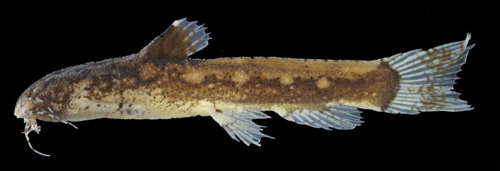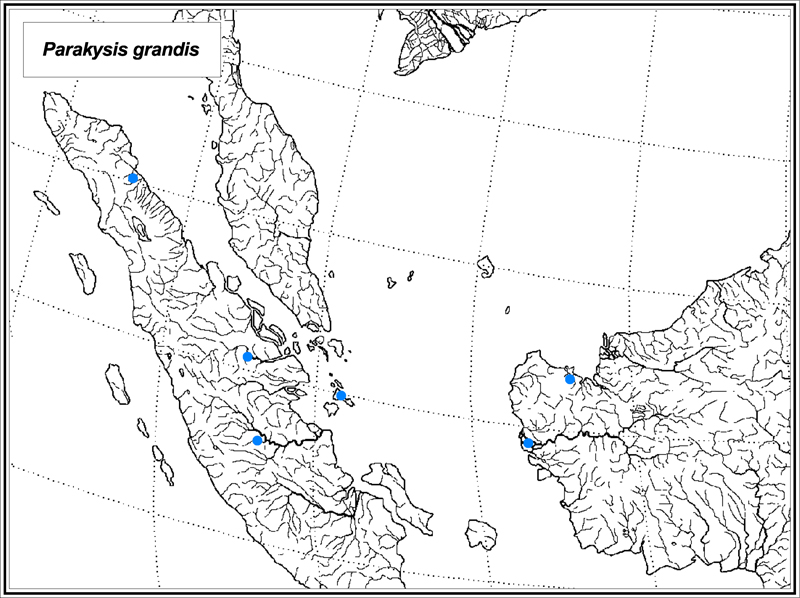
Parakysis grandis Ng & Lim 1995
Identification: P. grandis has a broad head with small, subcutaneous eyes. The upper lip has a median lobe projecting into a median concavity on the lower lip. There are 1-2 branches on the outer mandibular barbel. The inner mandibular barbel has 2-3 short, thick branches; the first 2 are almost always separated at the base. The mandibular latero-sensory canal has a pore lateral to the inner and outer mandibular barbels. The body tubercles are small. The dorsal fin has 1 spine and 4 rays; the first ray is sometimes branched, the rest are always branched. The pectoral fin has 1 spine and 6-7 rays; the innermost ray is sometimes branched, the following 5-6 rays are branched, and the outermost ray is sometimes branched. The pelvic fin has 6 rays; the first and last rays are sometimes branched, and the 4-5 median rays are always branched. The anal fin has 7-10 rays; the first 4 rays are simple, the following 3-6 rays are branched. The caudal fin has 12 rays; the uppermost and lowermost principal rays are simple and the 10 median rays are branched. The caudal fin has pointed lobes and secondary branching. There are 30-33 total vertebrae, 17-20 preanal vertebrae, and 11-13 postanal vertebrae. Maximum size = 62 mm SL.
Range: P. grandis is found in western Borneo in the Kapuas basin, in Sarawak in the Kuching basin, and in Sumatra in the Deli, Indragiri, Batang Hari and Musi basins.
Habitat: Woody debris in current of small streams.
Similar species: P. grandis can be distinguished from other members of the genus by the secondary branching of caudal fin rays in specimens larger than 30 mm SL. Other species lack the secondary branching of caudal fin rays. P. verrucosus and P. anomalopteryx have a narrower head; P. longirostis has a broad but more conical head when viewed dorsally. P. anomalopteryx lacks a lobe on the upper lip and corresponding median concavity on the lower lip. P. longirostris is most similar to P. grandis but has rounded caudal fin lobes. P. verrucosa and P. anomalopteryx have long, slender branches on the inner mandibular barbel that are joined at the base. At a maximum size of 62 mm SL, P. grandis is the largest species; others are less than 50 mm.
Information from:
Ng, H. H. and K. K. P. Lim. 1995. A revision of the southeast Asian catfish genus Parakysis (Teleostei: Akysidae), with descriptions of two new species. Ichthyological Exploration of Freshwaters 6 (3): 255-266.
Ng, H. H. and M. Kottelat. 2003. Parakysis notialis, a new species of akysid catfish from Borneo (Siluriformes: Akysidae). Ichthyological Research 50: 48-51.
